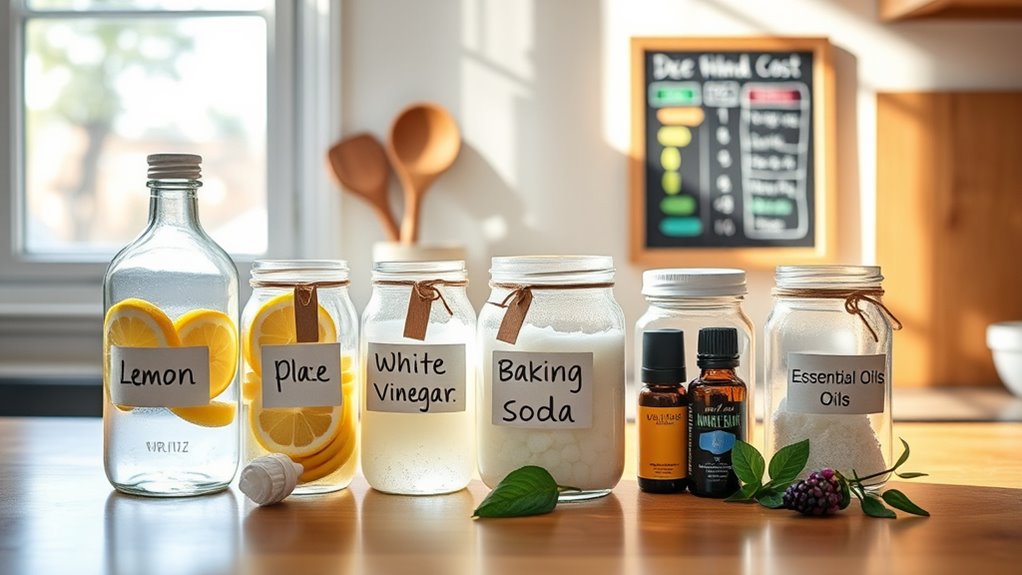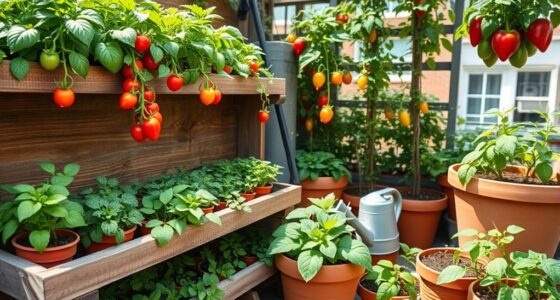Switching to DIY green cleaning products can save you money by using affordable ingredients like vinegar, baking soda, and essential oils, which last a long time. Store-bought eco-friendly cleaners cost more per bottle, but offer convenience and consistent results. While DIY solutions require some initial effort and equipment, they often prove more cost-effective over time and are better for the environment. Keep exploring to discover how you can make smart, budget-friendly cleaning choices.
Key Takeaways
- DIY cleaning ingredients like vinegar and baking soda are inexpensive, readily available, and last for months, reducing long-term costs.
- Store-bought eco-friendly cleaners cost $3–$6 per 16-ounce bottle but offer convenience and consistent results.
- Initial DIY setup costs are low, but time and effort for preparation may outweigh savings for busy schedules.
- DIY products generate less packaging waste and use biodegradable ingredients, making them more environmentally sustainable.
- The cost-effectiveness of DIY cleaning depends on ingredient prices, availability, and the balance between effort and long-term savings.
Breakdown of Common DIY Green Cleaning Ingredients and Their Costs
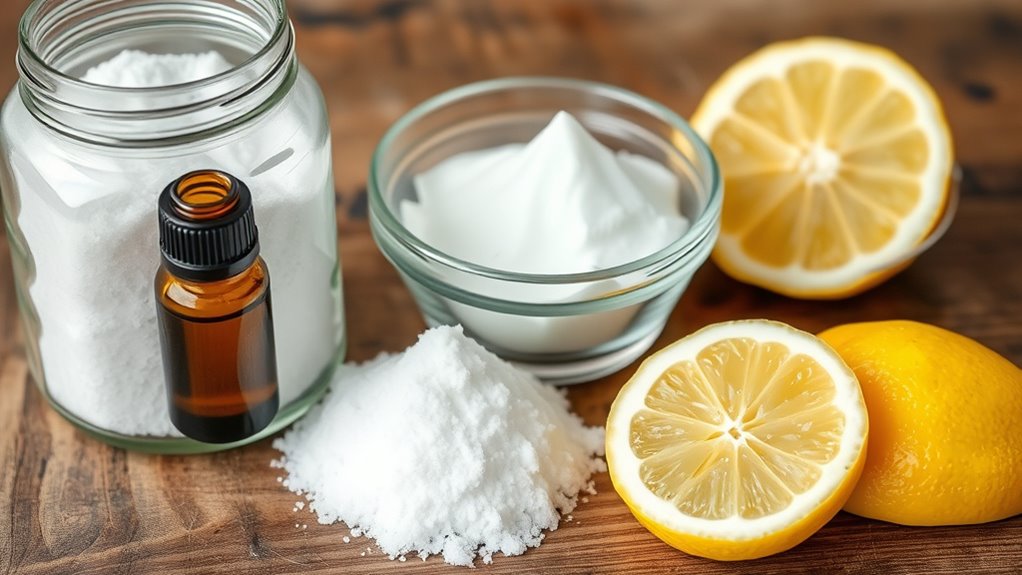
When you’re exploring DIY green cleaning products, understanding the costs of common ingredients can help you save money and make informed choices. Vinegar is one of the most affordable options, costing around $1 to $3 per quart, making it a versatile cleaner for surfaces and glass. Baking soda is similarly inexpensive, usually about $0.50 to $1 per pound, perfect for scrubbing and deodorizing. Essential oils, while more expensive—ranging from $5 to $15 per ounce—are used in small amounts, so they don’t markedly raise overall costs. Castile soap is another popular ingredient, costing approximately $4 to $8 per 12-ounce bottle. These ingredients are budget-friendly, effective, and readily available at most grocery stores or online, making them ideal for DIY green cleaning projects. Additionally, understanding herbal properties can inspire natural cleaning solutions using herbs like thyme or rosemary for added antimicrobial benefits. Incorporating environmentally friendly ingredients can further enhance the safety and sustainability of your homemade cleaners. For example, choosing ingredients with biodegradable qualities ensures your cleaning practices are more eco-conscious and reduce environmental impact. Moreover, selecting ingredients that are biodegradable and non-toxic aligns with the principles of green cleaning, ensuring your homemade solutions are safe for both your family and the environment. Using sustainable sourcing can also help minimize the ecological footprint of your DIY projects.
Cost Analysis of Popular Store-Bought Eco-Friendly Cleaners
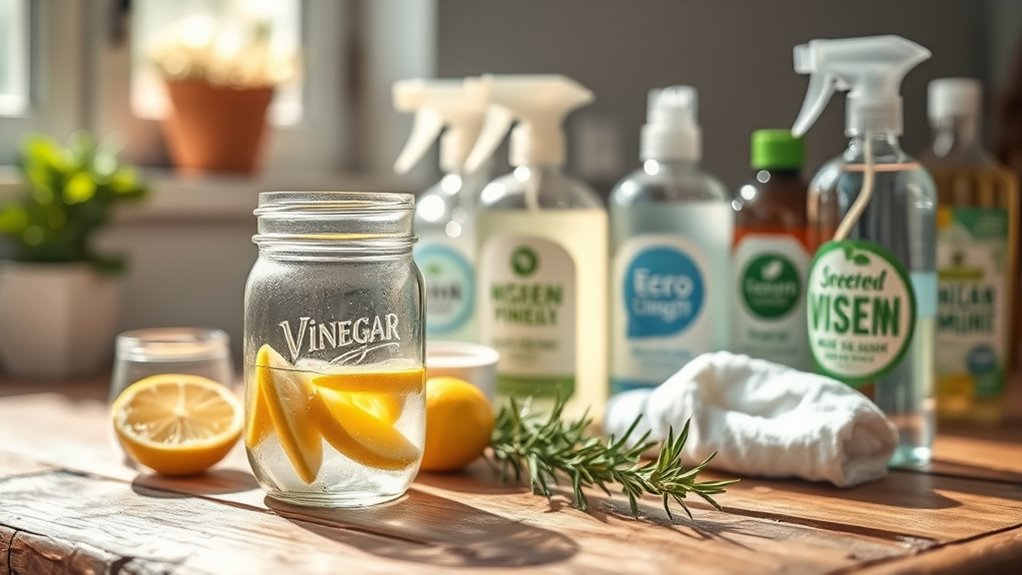
While DIY ingredients are cost-effective, many people prefer the convenience of store-bought eco-friendly cleaners. These products often come pre-mixed, saving you time and effort. Prices vary depending on brand and size, but many popular options cost between $3 and $6 for a 16-ounce bottle. For example, brands like Method or Seventh Generation offer multi-surface sprays that are effective and environmentally friendly. Although these cleaners tend to be pricier per use compared to homemade options, they provide consistency and ease of application. Larger bottles or refills can reduce overall costs, making them more economical over time. When choosing store-bought products, check labels for eco-certifications and ingredients to guarantee they align with your green cleaning goals. Additionally, considering the sustainable packaging on these products can help you select options that are both effective and environmentally responsible. Using proper storage techniques can further extend the lifespan of your purchased cleaners and maintain their efficacy, especially when storage conditions are optimized for chemical stability. Understanding the 16PF personality traits of yourself or others can also influence your choices by highlighting preferences for convenience or eco-consciousness, ensuring your cleaning routine aligns with your values.
Initial Investment: Supplies Needed for Homemade Cleaning Products
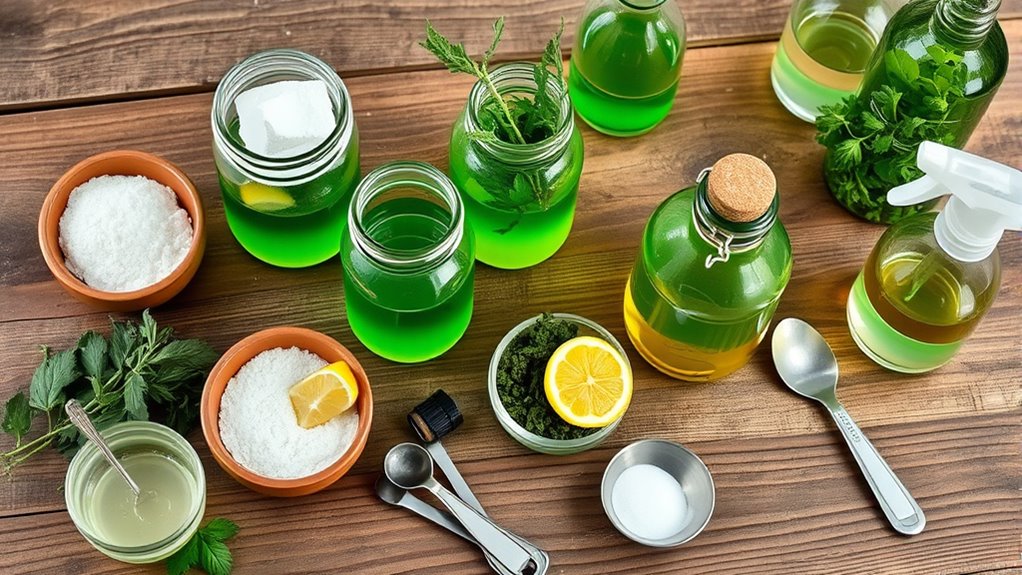
Getting started with homemade cleaning products requires an initial investment in basic supplies. You’ll need essential ingredients like vinegar, baking soda, and essential oils, along with some equipment such as spray bottles and measuring cups. This upfront cost varies depending on what you already have at home, but it’s generally affordable and reusable. Incorporating essential oils for cleaning can further streamline your cleaning routines and improve efficiency over time. Additionally, understanding cost-effective methods can help you maximize your savings while maintaining effective cleaning standards.
Essential Ingredients List
Are you ready to gather the essential ingredients for making your own green cleaning products? These basics form the foundation of effective, eco-friendly cleaners. You’ll need common, affordable supplies that can be reused or stored for future use. Here’s a quick overview:
| Ingredient | Purpose | Notes |
|---|---|---|
| White Vinegar | Disinfects and cuts grease | Dilute for most uses |
| Baking Soda | Deodorizes and scrubs | Great for surfaces and drains |
| Castile Soap | Cleans and foams | Choose unscented varieties |
With these ingredients, you can create a variety of cleaning solutions, saving money and reducing chemical exposure. Incorporating mindfulness techniques while cleaning can enhance your focus and create a more calming environment. Using natural ingredients like these aligns with the principles of eco-friendly practices and supports a healthier home. Keep these on hand, and you’ll be ready to tackle almost any mess while staying green.
Cost of Equipment
Starting your DIY green cleaning journey requires a modest initial investment in basic equipment, but the costs are minimal compared to buying commercial products. You’ll need simple items like spray bottles, measuring cups, and mixing bowls, which you can often reuse from household supplies. A funnel helps transfer liquids easily, and a scrub brush or microfiber cloth is essential for scrubbing surfaces. Most of these tools are inexpensive and can be purchased once, lasting for years. If you already have some items at home, your upfront costs decrease further. Additionally, choosing natural essential oils for cleaning solutions can enhance effectiveness without harmful chemicals. Using vacuum cleaner attachments like crevice tools or upholstery brushes can also improve cleaning efficiency when applied to different surfaces. Incorporating reusable cleaning tools helps reduce waste and ongoing costs, making your routine more sustainable. Investing in eco-friendly cleaning supplies can further reduce your environmental impact while saving money over time. Moreover, selecting biodegradable ingredients ensures your cleaning products are safe for the environment and your family. Unlike commercial cleaners that require continuous purchases, investing in these basic tools means you’ll save money over time. Overall, the initial equipment cost is low, making DIY green cleaning both affordable and sustainable.
Cost Per Use: Comparing DIY and Commercial Green Cleaners Over Time

When comparing the cost per use of DIY versus commercial green cleaners, it’s important to take into account how frequently you clean and the quantity of product needed for each task. DIY solutions often cost less per use because you make larger batches that last longer. Conversely, commercial products are usually more concentrated and designed for specific uses, which can affect cost efficiency. To evaluate effectively, consider:
DIY green cleaners are often more cost-effective over time, especially with larger batches and regular use.
- How often you clean each area
- The amount of product needed per cleaning session
- The shelf life of your DIY mixture versus store-bought bottles
Long-Term Savings: How DIY Cleaning Can Reduce Expenses
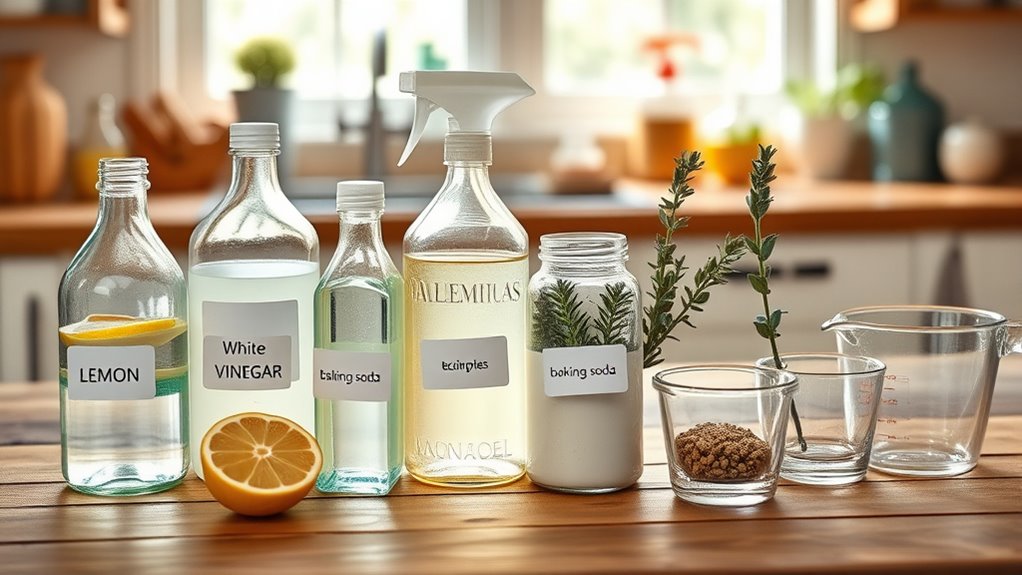
By making your own cleaning solutions, you can realize significant savings over time. Commercial cleaners often come with a markup that adds up quickly, especially if you buy them frequently. DIY recipes use simple, inexpensive ingredients like vinegar, baking soda, and lemon, which you can purchase in bulk. These ingredients last for months, meaning fewer trips to the store and lower overall expenses. Additionally, since you control the ingredients, you avoid paying for unnecessary chemicals and packaging. Over the long term, this approach reduces your cleaning costs considerably. Plus, making your own solutions allows you to customize formulas to suit your needs, avoiding waste and ensuring you’re only using what’s necessary. Overall, DIY cleaning is an effective way to save money while maintaining a healthy home.
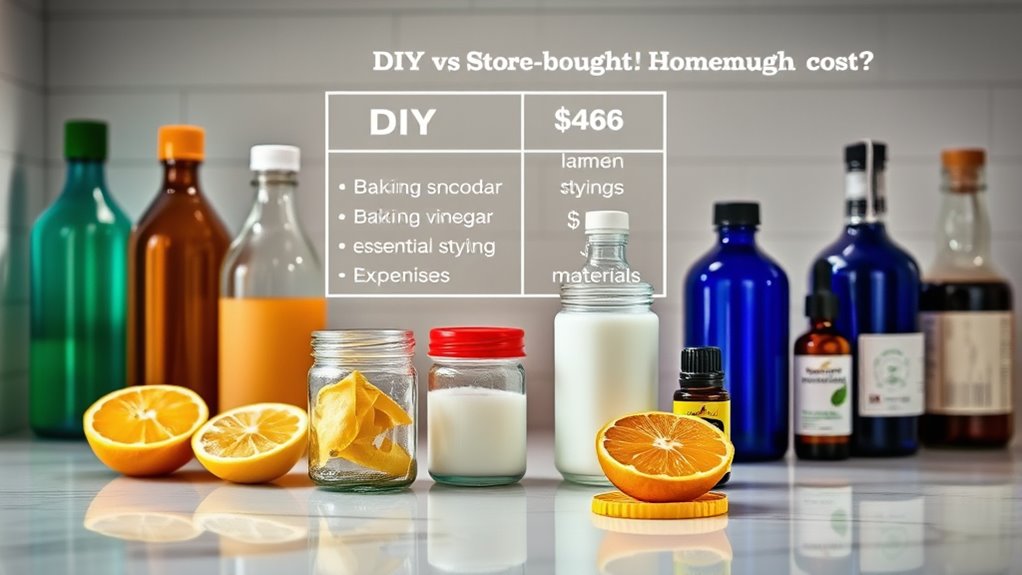
When comparing DIY and store-bought cleaning products, you’ll want to take into account ingredient costs and whether supplies are readily available. Keep in mind that creating your own cleaners takes time and effort, which can add to the overall expense. Additionally, think about the environmental impact and waste generated by each option to make an informed decision.
Ingredient Expenses and Availability
Ingredient costs and availability play a crucial role in determining whether DIY green cleaning products are more economical than store-bought options. First, some ingredients like baking soda and vinegar are inexpensive and readily available, making DIY options cheaper upfront. Second, specialty ingredients like essential oils or natural cleaners may be harder to find or more costly, increasing overall expenses. Third, sourcing ingredients locally or in bulk can reduce costs, but inconsistent availability might force you to buy from multiple suppliers or pay higher prices. If ingredients are scarce or expensive, the total cost of DIY products can surpass store-bought alternatives. Evaluating ingredient costs and knowing where to get them influences whether DIY is truly cost-effective for your green cleaning needs.
Time and Effort Invested
While ingredient costs influence your overall spending, the time and effort required to make DIY green cleaning products can considerably impact their true value. You’ll need to set aside time for gathering ingredients, measuring, mixing, and sometimes waiting for solutions to settle or activate. This process can be quick for simple recipes but becomes more time-consuming with complex formulations. Additionally, repeated DIY projects demand ongoing effort, which might not be practical if you’re busy. Store-bought options, while often more expensive upfront, save you time and effort, offering convenience and consistency. Consider whether you’re willing to invest the time needed for DIY products or if the convenience of ready-made cleaners better fits your lifestyle. Balancing effort with cost is key to making an informed choice.
Environmental Impact and Waste
Choosing between DIY green cleaning products and store-bought options also involves considering their environmental impact and waste. DIY solutions often produce less packaging waste, but you should be mindful of ingredient sourcing and disposal. Store-bought products may come in plastic containers that contribute to landfill waste and pollution. To evaluate their environmental footprint, consider these factors:
- Packaging waste – Are the containers recyclable or reusable?
- Ingredient sustainability – Are ingredients eco-friendly and responsibly sourced?
- Disposal effects – Does the product break down safely or harm ecosystems?
Environmental Impact and Cost Benefits of Making Your Own Cleaners
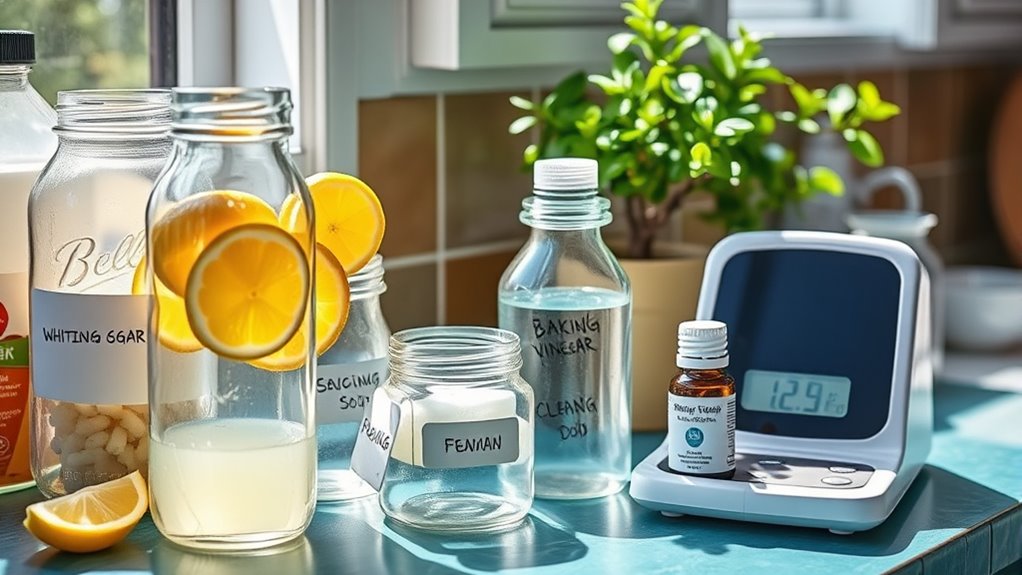
Making your own cleaning products can considerably reduce your environmental footprint and save you money. By choosing natural ingredients like vinegar, baking soda, and lemon, you cut down on plastic packaging and harmful chemicals commonly found in store-bought cleaners. These ingredients are biodegradable, so they break down more easily in the environment, minimizing pollution and harm to wildlife. Additionally, homemade cleaners are often more cost-effective because you use small amounts for multiple purposes, stretching your dollar further. Over time, the savings add up, and you’re less dependent on disposable bottles and chemical-laden products. Not only do you help protect the planet, but you also create a healthier indoor environment with fewer toxic fumes. Making your own cleaners is a simple way to support sustainability and reduce costs simultaneously.
Tips for Budget-Friendly DIY Green Cleaning Without Sacrificing Effectiveness
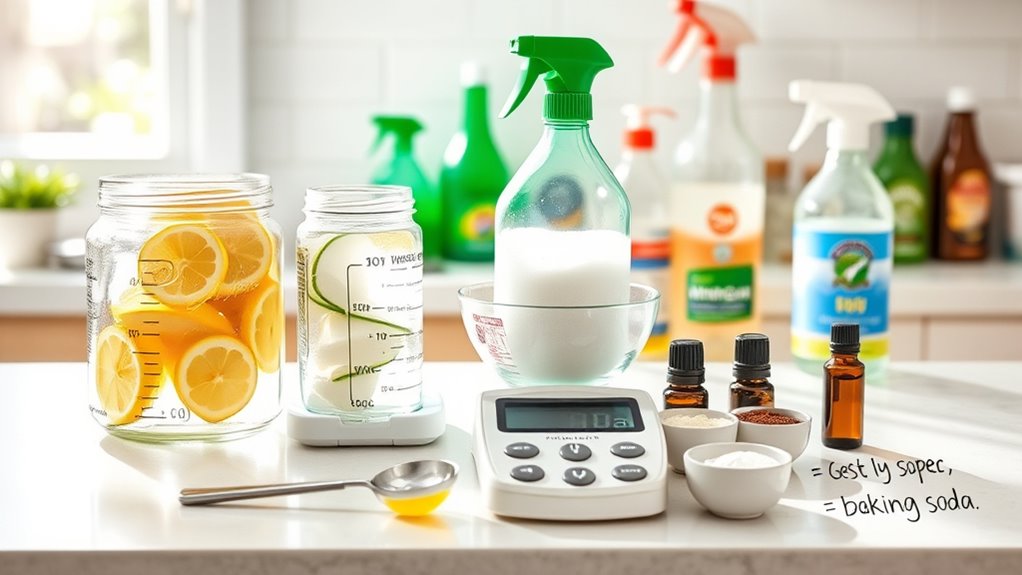
By focusing on simple, cost-effective ingredients and practical techniques, you can achieve powerful cleaning results without overspending. First, stick to common pantry items like baking soda, vinegar, and lemon juice—they’re inexpensive and effective. Second, use concentrated formulas: mix larger batches to save money and reduce waste. Third, target your cleaning efforts—focusing on high-traffic areas ensures you get the best results without overusing supplies. Additionally, reuse containers and store leftovers for future use. Always test new recipes on small areas first to prevent damage. Keep your cleaning routines simple, and avoid unnecessary products. With these tips, you’ll maintain a fresh, healthy home without sacrificing effectiveness or breaking the bank.
Frequently Asked Questions
How Do DIY Green Cleaners Compare in Effectiveness to Commercial Products?
When comparing DIY green cleaners to commercial products, you’ll find that effectiveness varies based on ingredients and cleaning needs. DIY solutions often work well for everyday messes and are gentle on surfaces, but they might not be as powerful against heavy grime or stubborn stains. You can customize recipes to suit specific tasks, but for tough jobs, commercial cleaners with specialized formulas may deliver quicker, more reliable results.
Are There Safety Concerns With Homemade Cleaning Ingredients?
When you make your own green cleaners, safety should be a top concern. You might accidentally mix harmful ingredients or use too much of a strong substance like vinegar or baking soda, which can cause skin irritation or damage surfaces. Always read labels, follow recommended amounts, and keep products out of reach of children and pets. Proper storage and ventilation are key to staying safe with homemade cleaners.
How Often Should I Make New Batches of DIY Cleaners?
Think of your DIY cleaners as a garden; they thrive best when fresh. You should make new batches every one to two weeks, especially if they contain perishable ingredients like citrus or herbs. If your cleaners are stored in a cool, dark place and contain stable ingredients, you can stretch to a month. Regularly check for changes in smell or color—these are signs it’s time to re-batch.
Can DIY Green Cleaners Handle Tough Stains Effectively?
You might wonder if DIY green cleaners can tackle tough stains. Generally, they can be effective, especially when you choose strong natural ingredients like baking soda, vinegar, or lemon juice. For stubborn stains, apply the cleaner directly and let it sit for a few minutes before scrubbing. However, for extremely tough or old stains, you might need to use a specialized product or combine natural remedies for better results.
What Are the Best Storage Practices for Homemade Cleaning Products?
When storing your homemade cleaning products, you should use airtight containers to prevent spills and evaporation. Keep them in a cool, dark place away from direct sunlight, heat, and humidity, which can degrade their effectiveness. Label each container clearly with ingredients and date made for safety and easy identification. Make sure lids are tightly sealed after every use to maintain their potency and prevent leaks.
Conclusion
By choosing DIY green cleaning products, you’re not just saving a few bucks—you’re releasing a cleaning revolution that could save you thousands, protect the planet, and turn your home into a sparkling sanctuary of health. Imagine never wasting money on harsh chemicals again, while making a gargantuan impact on the environment. It’s more than cleaning; it’s a powerful act of kindness to your wallet, your family, and Mother Earth—so start DIY-ing today and witness the incredible transformation!
